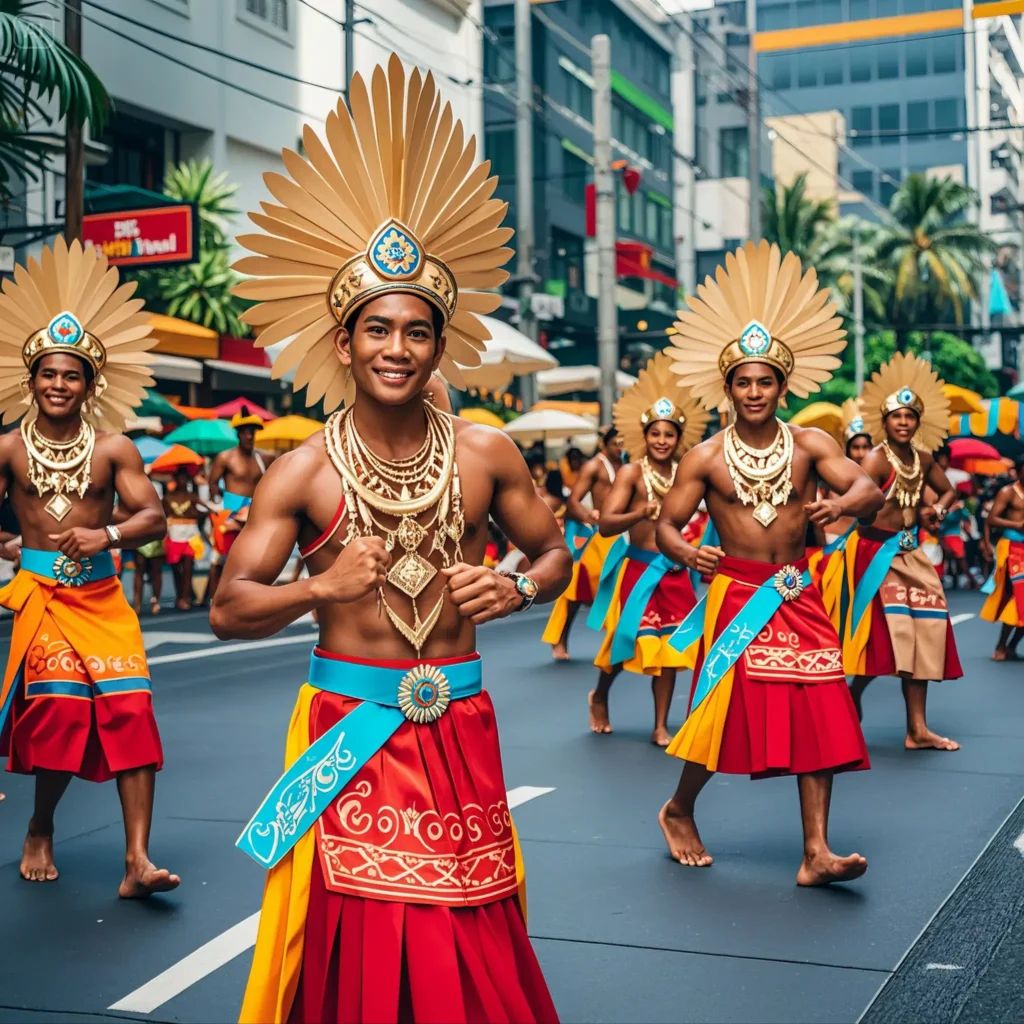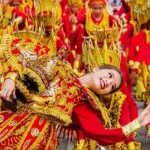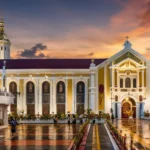Get ready to immerse yourself in the rich cultural heritage of Cebu, Philippines, as you learn the traditional Sinulog dance steps. This iconic prayer dance was born out of devotion to the Sto. Niño has been a cornerstone of the Sinulog Festival for over four decades.
As you follow the rhythmic beat, you’ll be tracing the footsteps of candle vendors, dancers, and devotees who have preserved this sacred tradition.
Key Takeaways:
- Original Sinulog Dance Steps: The traditional Sinulog dance involves one step forward and two steps backward, patterned after the dance ritual called “Sinug,” which imitates the waves of the sea.
- Religiosity and Faith: The Sinulog dance is a form of prayer and worship, and Val Sandiego and his dance company aim to preserve the original religiosity and authenticity of the dance, highlighting the importance of faith and devotion to the Sto. Niño.
- Cultural Significance: The Sinulog dance has a rich cultural heritage, dating back to 1521 when Portuguese explorer Ferdinand Magellan gave the image of the Sto. Niño to Cebu’s Queen Juana. The dance has evolved over the years, but its significance as a cultural and religious celebration remains strong.
Origins of Sinulog Dance
For you to fully appreciate the beauty and significance of the Sinulog dance, it’s crucial to understand its origins.
Historical Background
On the shores of Cebu, in 1521, Portuguese explorer Ferdinand Magellan gave a baptismal gift to Cebu’s Queen Juana – the Sto. Niño de Cebu. This marked the beginning of the Sinulog, a ritual prayer and dance to the Holy Child Jesus.
Evolution of the Dance
Sinulog, which means “like the sug” (sug being the Bisaya term for “wave”), imitated the waves of the sea. The dance itself was patterned after the dance ritual called “Sinug,” a dance prayer performed before the image of the Sto. Niño.
The original dance – one step forward and two steps backward – was later adopted by candle vendors at Basilica Minore del Sto. Niño, where they would dance and pray for the petitions of churchgoers buying their products. To this day, candle vendors still follow the original steps before the Sto. Niño image.
The Original Sinulog Steps
There’s a rich history behind the Sinulog dance, and understanding its origins is crucial to performing it the right way. In this chapter, we’ll investigate the original Sinulog steps and explore how they’ve evolved over time.
One Step Forward, Two Steps Backward
Originally, the Sinulog dance involved a simple yet meaningful step pattern – one step forward and two steps backward. This pattern was rooted in the “Sinug” dance ritual, which we’ll discuss later. The simplicity of this step pattern belied its significance, as it symbolized the devotion and humility of the dancers.
The “Sinug” Dance Ritual
An integral part of the Sinulog tradition is the “Sinug” dance ritual, which was performed before the image of the Sto. Niño. This ritual dance imitated the waves of the sea, known as “sug” in Bisaya, hence the term Sinug.
The “Sinug” dance ritual was more than just a dance – it was a prayer, a form of worship, and a way to connect with the divine. As you learn the Sinulog dance, remember that you’re not just performing a series of steps, but also paying homage to the rich cultural and religious heritage of Cebu.
Note, that the original Sinulog steps were meant to be a form of prayer and worship, so approach them with reverence and respect.
The Sandiego Dance Company
All eyes are on the Sandiego Dance Company, a group that has been synonymous with the Sinulog Festival for over four decades. With their unwavering dedication to preserving the tradition and devotion to the Sto. Niño, they have become an integral part of Cebu’s cultural heritage.
Preserving the Tradition
Anchored on their mission to preserve the authenticity of the Sinulog dance, the Sandiego Dance Company has been a beacon of hope for those who want to keep the tradition alive. Through their performances, they aim to educate and remind the people of Cebu about their rich cultural heritage.
Devotion to the Sto. Niño
On a deeper level, the Sandiego Dance Company’s performances are a testament to their unwavering devotion to the Sto. Niño. As devotees, they believe it is their responsibility to keep the tradition going and to put faith in their culture through the Sinulog.
Tradition is at the heart of the Sandiego Dance Company’s performances. They have been perfecting the original Sinulog dance steps, which were patterned after the dance ritual called “Sinug,” a dance prayer performed before the image of the Sto. Niño.
The Dance Routine
Many have attempted to master the Sinulog dance, but few have succeeded in capturing its true essence. To truly embody the spirit of the Sinulog, you must first understand the dance routine.
As you prepare to dance the Sinulog, remember that it’s not just about the steps – it’s about the faith, culture, and tradition behind it. So, let’s explore the dance routine that has been passed down through generations.
Spanish-Era Costumes
An integral part of the Sinulog dance is the attire. The male dancers wear uniforms reminiscent of Spanish soldiers, complete with swords and shields, while the female dancers don traditional Spanish-era costumes, carrying candles and handkerchiefs.
Depicting the Arrival of Christianity
The arrival of Christianity is a pivotal part of the Sinulog dance. The female dancers, carrying candles and handkerchiefs, reenact the arrival of Christianity in Cebu through a dramatic dance.
For instance, the dance depicts the story of how Portuguese explorer Ferdinand Magellan brought Christianity to Cebu, and how the Sto. Niño became an integral part of the island’s culture and faith. This powerful depiction is a testament to the enduring legacy of Christianity in Cebu.
Faith and Perseverance
Unlike other festivals, Sinulog is deeply rooted in faith and religiosity. The dance itself is a form of prayer, a way to honour the Sto. Niño and show devotion to the Christian faith.
Overcoming Adversities
Adversities may arise, but with faith and perseverance, they can be overcome. The Sandiego Dance Company faced a major setback when their house and dance studio were destroyed by a fire in 2001, but they still managed to perform during the Sinulog Festival, clad only in white shirts and plain pants.
Unwavering Devotion
On the day of the Sinulog Festival, dancers from the Sandiego Dance Company gather to perform, each with their own petition to the Sto. Niño. They dance with unwavering devotion, seeking healing, success, or guidance.
For instance, Val Sandiego’s mother, Luz, made a vow to the Sto. Niño made the performance better, grander, and more festive every year, as she asked the Holy Child Jesus to cure her husband, Rafael, who was suffering from brain cancer. Rafael was eventually cured, and Luz continued to perform the Sinulog dance as a way to show her gratitude.
The Significance of Sinulog Dance
Despite its evolution over the years, the Sinulog dance remains a vital part of Cebu’s cultural and religious heritage.
Cultural Heritage
One of the most notable aspects of the Sinulog dance is its connection to Cebu’s rich cultural heritage. The dance has been passed down through generations, with each performance serving as a testament to the island’s history and traditions.
Religious Significance
The Sinulog dance is deeply rooted in the Catholic faith, specifically in the devotion to the Sto. Niño. It originated as a prayer dance, with the original steps mimicking the waves of the sea, symbolizing the faith and devotion of the Cebuanos to the Holy Child Jesus.
To truly appreciate the Sinulog dance, you must understand its religious significance. The dance is not just a form of entertainment, but a form of worship, a way to express gratitude and devotion to the Sto. Niño. As Val Sandiego, the leader of the Sandiego Dance Company, puts it, “As a devotee of the Sto. Niño, I feel that I have a responsibility to keep the tradition going. We need to put faith into our culture through the Sinulog.”
Conclusion
The Sinulog dance steps, rooted in religiosity and tradition, are a testament to the devotion of the Cebuanos to the Sto. Niño. You’ve learned the origins of this sacred dance, from its humble beginnings as a prayer ritual to its evolution into a vibrant cultural celebration.
As you take the next step in your Sinulog journey, remember the importance of preserving the authenticity of this worship dance, just as Val Sandiego and his family have done for generations.
Frequently Asked Questions
Q: What are the original dance steps of the Sinulog?
A: The original dance steps of the Sinulog are one step forward and two steps backward, patterned after the dance ritual called “Sinug,” a dance prayer performed before the image of the Sto. Niño. This dance imitated the waves of the sea, which is called “sug” in Bisaya, where the term Sinug was coined.
Q: What is the significance of the Sinulog dance?
A: The Sinulog dance is a form of prayer and worship to the Sto. Niño and it is a way to express devotion and faith to the Holy Child Jesus. It is a cultural and religious celebration that has been passed down through generations, and it is an important part of the Sinulog Festival in Cebu.
Q: How did the Sinulog dance evolve over time?
A: Over time, the Sinulog dance has evolved and modernized, with some groups incorporating new choreography and music. However, the original traditional prayer dance has been preserved by groups like the Sandiego Dance Company, who aim to keep the authenticity of the worship dance.


